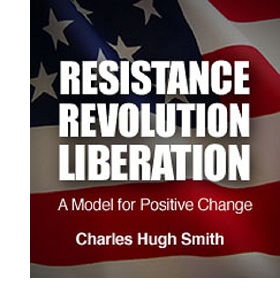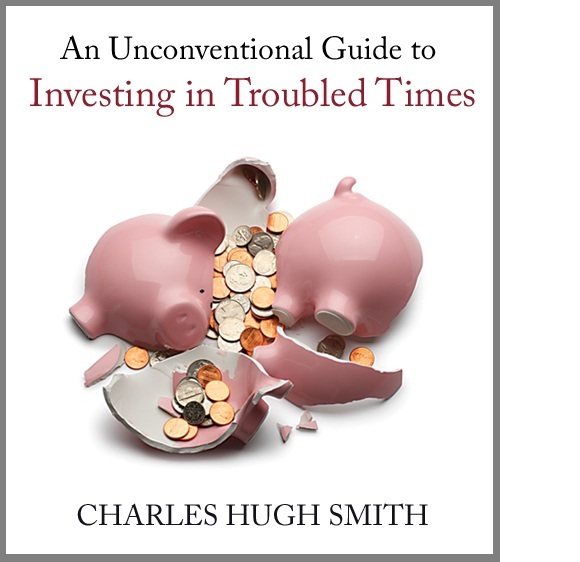

|

|
|||||||||||||||||||||||
|
Where's the Collateral? (May 1, 2012) A sound system of credit is built on collateral. A doomed system of debt sits precariously on phantom collateral. The global "recovery" is based not on reducing debt but on increasing it. Nice, but where's the collateral? The basic idea of debt is that credit is extended based on collateral, i.e. something of enduring, tradable value, or an income stream that isn't reduced to zero by non-discretionary spending and taxes. A funny thing happened to collateral like housing equity and financial assets in the past four years--it shrank by trillions of dollars. According to the latest Z1 "Balance Sheet of Households and Non-Profits" from the Federal Reserve, real estate fell by $4.9 trillion since the bubble top in 2007 and owners' equity lost $4.2 trillion. Despite the stock market doubling since 2009 and a healthy run-up in the value of bonds, financial assets shrank by $2 trillion as well. These are non-trivial sums when we consider that collateral is generally leveraged. If a home buyer puts down 20% cash, then that cash collateral is leveraged 4-to-1 in an 80% mortgage. If the buyer puts down 3% (as in an FHA loan), then the leverage is over 30-to-1. Collateral matters when it comes to assessing the value of the debt. If a bank lists the mortgages in its "assets" column at full value even though the underlying collateral (the houses) has lost much of their value, then the bank is grossly over-estimating the value and security of the mortgage. The bank's "assets" are based on phantom collateral. Take away $1 in collateral and you impair $4, $10, $20 or even $30 of debt. Recall that the vast majority of real estate equity and financial wealth is owned by the top 20%, with the majority of that concentrated in the top 5%. That means the bottom 80% own little collateral to leverage into debt.
How about leveraging income into more debt? Since the top 10% receive almost 50% of the income, and most of the bottom 90%'s income goes to non-discretionary spending and taxes, then only the top 10% have discretionary income that can be leveraged into more debt. Interestingly, The Wedge between Productivity and Wages by economist Mark Thoma reports that the enormous advances in productivity over the past few decades did not translate into higher wages for the bottom 90%.
I have often addressed income disparity and the evaporation of collateral, for example, Two Americas: The Gap Between the Top 5% and the Bottom 95% Widens (August 18, 2010) and The Housing Bubble Broke the Middle Class (April 27, 2011). Regardless of the various causal factors, the fact remains that 90% of American households have limited collateral or discretionary income to leverage into more debt. That leaves around 10 million households (the top 10%) with the means to take on more debt--if they want to. Can 10% of the households prop up the entire economy with more debt and consumption? What if the wealthy decline the opportunity to leverage more debt? We can also ask "where's the collateral?" of the banking sector. As frequent contributor Harun I. observed about the European banking sector's phantom collateral:
European banks do not have enough money for deposit redemptions (people withdrawing their cash from the banks) and the only way to get it is to have the European Central Bank (ECB) print money out of thin air thereby devaluing every euro, thereby destroying purchasing power (you get your money but it buys less). Put these two factors together and you get a global economy dependent on debt borrowed against phantom collateral and an American economy in which only the top 10% have credible collateral and income to leverage into more debt. In a sane system, when the collateral vanishes, so too does the debt (writedowns, write-offs, bankruptcy, take your pick). In an insane system, then phantom collateral supports ever greater mountains of debt.
How long do you reckon the insane system we have now will last? The collateral is phantom,
but the interest payments are very, very real.
 Resistance, Revolution, Liberation: A Model for Positive Change
(print $25)
Resistance, Revolution, Liberation: A Model for Positive Change
(print $25)
(Kindle eBook $9.95) Read the Introduction (2,600 words) and Chapter One (7,600 words) for free.
We are like passengers on the Titanic ten minutes after its fatal encounter with the iceberg: though our financial system seems unsinkable, its reliance on debt and financialization has already doomed it.

If this recession strikes you as different from previous downturns, you might
be interested in my book
An Unconventional Guide to Investing in Troubled Times (print edition)
or
Kindle ebook format. You can read the ebook on any
computer, smart phone, iPad, etc. Click here for links to Kindle apps and Chapter One.
The solution in one word: Localism.
Of Two Minds Kindle edition: Of Two Minds blog-Kindle

"This guy is THE leading visionary on reality.
He routinely discusses things which no one else has talked about, yet,
turn out to be quite relevant months later."
NOTE: gifts/contributions are acknowledged in the order received. Your name and email remain confidential and will not be given to any other individual, company or agency.
All content, HTML coding, format design, design elements and images copyright © 2012 Charles Hugh Smith, All rights reserved in all media, unless otherwise credited or noted. I would be honored if you linked this essay to your site, or printed a copy for your own use.
Terms of Service:
|
|
Add oftwominds.com to your reader:
My Big Island Girl
Instrumentals by my friend
|